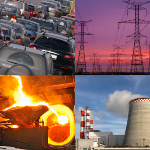Climate Change
U.S. Greenhouse Gas Inventory Report

Stakeholder Workshops
On September 13-14, 2012, EPA held a stakeholder workshop on key aspects of the estimates of greenhouse gas emissions from the natural gas sector in the Inventory of U.S. Greenhouse Gas Emissions and Sinks. View speaker presentations and learn more about the workshop.
Related Links
Visit the Greenhouse Gas Emissions Home page for basic information on the main greenhouse gases and their sources, as well as information on global emissions, facility-level emissions in the United States, and Individual Emissions (your carbon footprint).
Visit the U.S. Greenhouse Gas Inventory Report Archive to view the past Inventory Reports.
GHG Reporting Program Data
EPA's Greenhouse Gas Reporting Program (GHGRP) collects annual greenhouse gas (GHG) data from facilities that directly emit large amounts of GHGs and from suppliers of certain fossil fuels and industrial gases.
This data can be accessed through EPA's online data publication tool. For more detail on the similarities and differences between the GHGRP data and the U.S. Greenhouse Gas Emissions Inventory, please review this fact sheet (PDF) (PDF, 2 pp, 461K, About PDF). For more additional information on the differences between these data sets please see this informational note (PDF) (2 pp., 44K, About PDF).
EPA develops the national greenhouse gas inventory each year to track the national trend in emissions and removals since 1990. The national greenhouse gas inventory is submitted to the United Nations in accordance with the Framework Convention on Climate Change.
![]() In preparing the annual emissions inventory report, EPA collaborates with hundreds of experts representing more than a dozen U.S. government agencies, academic institutions, industry associations, consultants and environmental organizations.
In preparing the annual emissions inventory report, EPA collaborates with hundreds of experts representing more than a dozen U.S. government agencies, academic institutions, industry associations, consultants and environmental organizations.
INVENTORY OF U.S. GREENHOUSE GAS EMISSIONS AND SINKS: 1990-2010
(April 2012)
The Inventory of U.S. greenhouse gas emissions and sinks tracks the national trend in greenhouse gas emissions and removals back to 1990. The report contains total U.S. emissions by source, economic sector and greenhouse gas. EPA uses national energy data, data on national agricultural activities, and other national statistics to provide a comprehensive accounting of total GHG emissions for all man-made sources in the United States. EPA also collects greenhouse gas emissions data from individual facilities and suppliers of certain fossil fuels and industrial gases through the Greenhouse Gas Reporting Program. The key findings of the 1990-2010 US Inventory include:
- In 2010, U.S. greenhouse gas emissions totaled 6,821.8 million metric tons CO2 Eq.
- U.S. emissions rose by 3.2% from 2009 to 2010. This increase was primarily due to an increase in economic output resulting in an increase in energy consumption across all sectors and much warmer summer conditions resulting in an increase in electricity demand for air conditioning.
- Since 1990, U.S. greenhouse gas emissions have increased by 10.5%.
Read or download the entire Inventory of U.S. Greenhouse Gas Emissions and Sinks: 1990-2010 (PDF, 481 pp., 16.6 MB, About PDF ). For faster access, individual report sections are posted below, for example the Executive Summary (PDF, 28 pp., 460 KB).
Individual sections of the report are also available for download:
Upfront (PDF) (6 pp, 41K) - Includes title page, acknowledgments and preface.
Table of Contents (PDF) (16 pp, 271 KB) - Plus a list of tables and figures.
Executive Summary (PDF) (28 pp, 460 KB) - Provides a broad overview of all U.S. greenhouse gas emission sources and sinks, introduces key concepts and discusses the primary drivers for changes in emissions. All material in the Executive Summary is drawn from the following chapters.
Introduction (PDF) (21 pp, 452 KB) - Includes background information on greenhouse gas emission inventories, an introduction to climate change, a discussion of methodological issues and plans for QA/QC and an uncertainty analysis.
Trends in Greenhouse Gas Emissions (PDF) (35 pp, 548 KB) - Provides an overview of emission trends and discusses the primary drivers for changes in emissions.
Energy (PDF) (74 pp, 1.76 MB) - Discusses and quantifies energy related emissions of all greenhouse gases resulting from stationary and mobile source activities including fuel combustion and fugitive fuel emissions.
Industrial Processes (PDF) (85 pp, 2.7 KB) - Addresses emissions from industrial processes not directly related to energy activities.
Solvent and Other Product Use (PDF) (6 pp, 96 KB) - Addresses emissions resulting from the use of solvents and evaporative emissions of greenhouse gases arising from other types of product use.
Agriculture (PDF) (41 pp, 5.5 MB) - Addresses anthropogenic emissions from agricultural activities (not including fuel combustion and sewage emissions, which are addressed in the Energy and Waste chapters).
Land Use, Land-Use Change, and Forestry (PDF) (74pp, 7.1 MB) - Addresses emissions and removals from forest and land-use change activities, primarily carbon dioxide.
Waste (PDF) (25 pp, 332 KB) - Addresses emissions from waste management activities.
Other (PDF) (2 pg, 37 KB) - Addresses emissions from the "Other" IPCC sector.
Recalculations and Improvements (PDF) (8 pp, 130 KB) - Includes an overview of changes in this year's report, including historical data, methodology and other changes relative to the 1990-2009 report.
References (PDF) (60 pp, 456 KB)
All Annexes (PDF) (389 pp, 10.6 MB) - Supplementary information, data tables, detailed emission calculations and methodological discussions.
Annex Introduction and TOC (PDF) (1 pg, 219 KB)
Annex 1 (PDF) (26 pp, 2.5 MB) - Key Category Analysis.
Annex 2 (PDF) (92 pp, 2.7 MB) - Methodology and Data for Estimating CO2 Emissions from Fossil Fuel Combustion.
Annex 3 (PDF) (232 pp, 9.6 MB) - Methodological Descriptions for Additional Source or Sink Categories.
Annex 4 (PDF) (10 pp, 623 KB) - IPCC Reference Approach for Estimating CO2 Emissions from Fossil Fuel Combustion.
Annex 5 (PDF) (2 pp, 268 KB) - Assessment of the Sources and Sinks of Greenhouse Gas Emissions Not Included.
Annex 6 (PDF) (24 pp, 1.3 B) - Additional Information.
Annex 7 (PDF) (21 pp, 776 KB) - Uncertainty.
